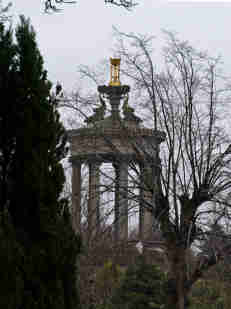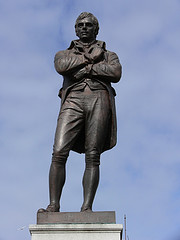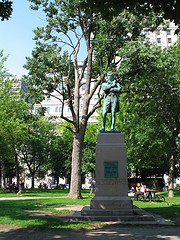|
Alloway Monument and Statue.
Also Statues at Ayr, Melbourne, Detroit, Vancouver, Montreal and Winnipeg.
I would welcome a photograph of the Statue within this monument at Alloway..

On 24th March 1814, Alexander Boswell of Auchinleck issued an invitation to a preliminary meeting at Ayr to discuss a memorial project. Only one person answered this invitation, and that was the Rev. Hamilton Paul who had played a leading role in the Alloway anniversary dinners from 1801 onwards. These two gentlemen, however, soon overcame the apathy of their fellow citizens and eventually raised £3,300 - a relatively large sum for those days. The money was used for the erection of a national monument on the bank of the River Doon at Alloway, near the poet's birthplace. The monument was designed by the noted Edinburgh architect, Thomas Hamilton, who later designed the Burns monument on Calton Hill in his native city. Hamilton was steeped in the classical tradition, as these two monuments testify.
The Alloway monument consists of a three sided rustic basement supporting a circular Corinthian peristyle, surmounted by a cupola. The massive substructure was carefully sited so that each side faced one of the three divisions of Ayrshire, namely Carrick, Cunninghame and Kyle. The interior of the basement formed a circular chamber, intended as a repository of relics of the poet. The superstructure consists of nine columns, representing the nine muses, and the frieze of their entablature is richly decorated with chaplets of laurel. The design of the central column was copied from the temple of Jupiter Stater in the Campo Vaccini in Rome.
No plans were made for some form of sculpture to occupy this monument, and it was not until 1845 that anything was done to remedy this defect. In the summer of 1844 the great Festival in honour of the sons of Burns was held at Alloway. One of the participants was the sculptor Patric Park, who remarked to several of his friends at the time that it was a great pity there was no figure of the poet in the monument. From this discussion Park formed a plan to sculpt a bust of Burns in white marble. The work was completed by September 1845 and then offered as a gift to the monument committee. Two years elapsed before the committee got around to having the bust installed, on a pedestal of Aberdeen granite. The bust is clearly based on the Nasmyth painting, but it was subject to a great deal of criticism at the time, on the grounds that it was not a very good likeness and devoid of those natural features which were characteristic of the popular conception of the poet. It has to be admitted that such views, like the sculptor's interpretation, are entirely subjective.
Ayr Statue

Alloway may have had its Grecian temple, but the people of Ayr felt that a statue of Burns in some central position would be more appropriate. Through the exertions of the local Burns club the necessary funds were raised and the London sculptor George Anderson Lawson (1832-1904) was commissioned to sculpt the standing figure which was unveiled on 8th July 1891.
For once art-critics and laymen were united in their praise of this statue. Pinnington echoed popular feeling when he wrote: 'At Ayr, Mr Lawson has quickened intellectual force with poetic fire and passion. The arms are crossed, the hands clenched, and the gaze earnest and concentrated to the simple grace of the figure elements are added of both thought and repressed feeling. Burns might have stood thus reading his poems to Edinburgh society; thus he might have written his impassioned farewell to Clarinda, conned his ode to Mary, or finished the ringing Scots Wha Hae.
The work can neither be located by incident, nor specialized in respect of sentiment. It is Burns broadly generalized the inseeing, rapt, intense poet... The freedom, grasp and breadth of the basic idea of the work indicate a sculptor whose knowledge of Burns was not exhausted upon his coat and breeches.'
Lawson's statue was widely regarded as the most successful statue of Burns sculpted up to that time, and it is hardly surprising that soon it began to rival the Steell figure in global esteem.
Replicas were erected at Melbourne (Princes Bridge, St Kilda Road) on 23rd January 1904,
Detroit on 23rd July 1921.
Vancouver (Stanley Park) on 25th August 1928.
Montreal (Dominion Square) on 18th October 1930.

Winnipeg (Manitoba Legislative Assembly Grounds) in 1936.
In the case of the last-named a bronze plaque was added and unveiled on 25th October 1952.
Bronze reductions of the statue were unveiled in Belfast's Free Library and Art Gallery in September 1893 and later installed in Ayr Old Church. Another was presented in 1938 by James B. McLennan of Coylton to the British Institute at the Sorbonne in Paris. During the Nazi occupation the statue was hidden in a box in a cellar underneath a pile of empty coal sacks. When Paris was liberated in 1944 the statue was removed from its hiding place, cleaned and restored to its original position. In recognition of the care taken by the Institute in preventing the statue falling into German hands, the Burns Federation in 1946 presented a set of the Scottish National Dictionary to the Sorbonne. The Lawson statue is also known to have been cast as a reduction, standing a metre high, in solid silver. One of these statuettes was sold in 1940 to A.E. Pickard, the Glasgow eccentric and self-styled 'Independent Millionaire'.
The Ayr statue has a set of four bronze bas-reliefs set into the pedestal. Lawson himself sculpted the panels showing Tam O' Shanter and Cutty Sark at the keystane of the auld brig, and a scene from 'The Cotter's Saturday Night'. A young Ayrshire sculptor, David McGill, sculpted the third panel, presented by the Freemasons of Scotland and showing a racy scene from The Jolly Beggars'. The fourth, or American panel was the gift of 25 citizens of the United States and was sculpted by George E. Bissell of Poughkeepsie, New York, showing the tender parting scene of Burns and Highland Mary. The Melbourne statue (now in the Treasury Gardens) likewise has decorative panels which show scenes from The Cotter' and Tam O' Shanter' as well as Burns at the plough.
|
| |
